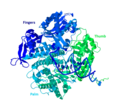
In biochemistry, a polymerase is an enzyme (EC 2.7.7.6/7/19/48/49) that synthesizes long chains of polymers or nucleic acids. DNA polymerase and RNA polymerase are used to assemble DNA and RNA molecules, respectively, by copying a DNA template strand using base-pairing interactions or RNA by half ladder replication.
A DNA polymerase from the thermophilic bacterium, Thermus aquaticus (Taq) (PDB 1BGX, EC 2.7.7.7) is used in the polymerase chain reaction, an important technique of molecular biology.
A polymerase may be template-dependent or template-independent. Poly-A-polymerase is an example of template independent polymerase. Terminal deoxynucleotidyl transferase also known to have template independent and template dependent activities.
By function
| DNA-polymerase | RNA-polymerase | |
|---|---|---|
| Template is DNA | DNA dependent DNA-polymerase or common DNA polymerases |
DNA dependent RNA-polymerase or common RNA polymerases |
| Template is RNA | RNA dependent DNA polymerase or Reverse transcriptase |
RNA dependent RNA polymerase or RdRp or RNA-replicase |
- DNA polymerase (DNA-directed DNA polymerase, DdDP)
- Family A: DNA polymerase I; Pol γ, θ, ν
- Family B: DNA polymerase II; Pol α, δ, ε, ζ
- Family C: DNA polymerase III holoenzyme
- Family X: Pol β, λ, μ
- Terminal deoxynucleotidyl transferase (TDT), which lends diversity to antibody heavy chains.
- Family Y: DNA polymerase IV (DinB) and DNA polymerase V (UmuD'2C) - SOS repair polymerases; Pol η, ι, κ
- Reverse transcriptase (RT; RNA-directed DNA polymerase; RdDP)
- DNA-directed RNA polymerase (DdRP, RNAP)
- Multi-subunit (msDdRP): RNA polymerase I, RNA polymerase II, RNA polymerase III
- Single-subunit (ssDdRP): T7 RNA polymerase, POLRMT
- Primase, PrimPol
- RNA replicase (RNA-directed RNA polymerase, RdRP)
- Viral (single-subunit)
- Eukaryotic cellular (cRdRP; dual-subunit)
- Template-less RNA elongation
By structure
Polymerases are generally split into two superfamilies, the "right hand" fold (InterPro: IPR043502) and the "double psi beta barrel" (often simply "double-barrel") fold. The former is seen in almost all DNA polymerases and almost all viral single-subunit polymerases; they are marked by a conserved "palm" domain. The latter is seen in all multi-subunit RNA polymerases, in cRdRP, and in "family D" DNA polymerases found in archaea. The "X" family represented by DNA polymerase beta has only a vague "palm" shape, and is sometimes considered a different superfamily (InterPro: IPR043519).
Primases generally don't fall into either category. Bacterial primases usually have the Toprim domain, and are related to topoisomerases and mitochondrial helicase twinkle. Archae and eukaryotic primases form an unrelated AEP family, possibly related to the polymerase palm. Both families nevertheless associate to the same set of helicases.
See also
- Central dogma of molecular biology
- Exonuclease
- Ligase
- Nuclease
- PCR
- PARP
- Reverse transcription polymerase chain reaction
- RNA ligase (ATP)
References
- Loc'h J, Rosario S, Delarue M (September 2016). "Structural Basis for a New Templated Activity by Terminal Deoxynucleotidyl Transferase: Implications for V(D)J Recombination". Structure. 24 (9): 1452–63. doi:10.1016/j.str.2016.06.014. PMID 27499438.
- Hansen JL, Long AM, Schultz SC (August 1997). "Structure of the RNA-dependent RNA polymerase of poliovirus". Structure. 5 (8): 1109–22. doi:10.1016/S0969-2126(97)00261-X. PMID 9309225.
- Cramer P (February 2002). "Multisubunit RNA polymerases". Current Opinion in Structural Biology. 12 (1): 89–97. doi:10.1016/S0959-440X(02)00294-4. PMID 11839495.
- Sauguet L (September 2019). "The Extended "Two-Barrel" Polymerases Superfamily: Structure, Function and Evolution". Journal of Molecular Biology. 431 (20): 4167–4183. doi:10.1016/j.jmb.2019.05.017. PMID 31103775.
- Salgado PS, Koivunen MR, Makeyev EV, Bamford DH, Stuart DI, Grimes JM (December 2006). "The structure of an RNAi polymerase links RNA silencing and transcription". PLoS Biology. 4 (12): e434. doi:10.1371/journal.pbio.0040434. PMC 1750930. PMID 17147473.
- Aravind L, Leipe DD, Koonin EV (September 1998). "Toprim--a conserved catalytic domain in type IA and II topoisomerases, DnaG-type primases, OLD family nucleases and RecR proteins". Nucleic Acids Research. 26 (18): 4205–13. doi:10.1093/nar/26.18.4205. PMC 147817. PMID 9722641.
- Iyer LM, Koonin EV, Leipe DD, Aravind L (2005). "Origin and evolution of the archaeo-eukaryotic primase superfamily and related palm-domain proteins: structural insights and new members". Nucleic Acids Research. 33 (12): 3875–96. doi:10.1093/nar/gki702. PMC 1176014. PMID 16027112.
External links
| DNA replication (comparing prokaryotic to eukaryotic) | |||||||
|---|---|---|---|---|---|---|---|
| Initiation |
| ||||||
| Replication |
| ||||||
| Termination | |||||||
| Transferases: phosphorus-containing groups (EC 2.7) | |||||||||||||||
|---|---|---|---|---|---|---|---|---|---|---|---|---|---|---|---|
| 2.7.1-2.7.4: phosphotransferase/kinase (PO4) |
| ||||||||||||||
| 2.7.6: diphosphotransferase (P2O7) | |||||||||||||||
| 2.7.7: nucleotidyltransferase (PO4-nucleoside) |
| ||||||||||||||
| 2.7.8: miscellaneous |
| ||||||||||||||
| 2.7.10-2.7.13: protein kinase (PO4; protein acceptor) |
| ||||||||||||||
| Enzymes | |
|---|---|
| Activity | |
| Regulation | |
| Classification | |
| Kinetics | |
| Types |
|
